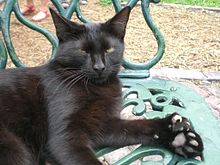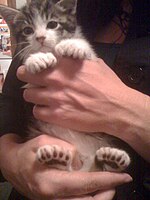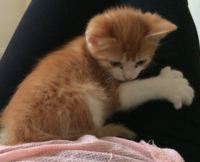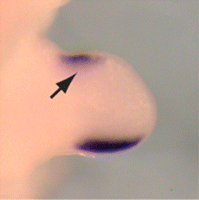
The Maine Coon is a large domesticated cat breed. One of the oldest natural breeds in North America, the breed originated in the U.S. state of Maine, where it is the official state cat.

Polydactyly is a birth defect that results in extra fingers or toes. The hands are more commonly involved than the feet. Extra fingers may be painful, affect self-esteem, or result in clumsiness.

Sonic hedgehog protein (SHH) is encoded for by the SHH gene. The protein is named after the video game character Sonic the Hedgehog.

A paw is the soft foot-like part of a mammal, generally a quadruped, that has claws.

The Silkie is a Chinese breed of chicken named for its atypically fluffy plumage, which is said to feel like silk and satin. The breed has several other unusual qualities, such as black skin and bones, blue earlobes, and five toes on each foot, whereas most chickens have only four. They are often exhibited in poultry shows, and also appear in various colors. In addition to their distinctive physical characteristics, Silkies are well known for their calm and friendly temperament. It is among the most docile of poultry. Hens are also exceptionally broody, and care for young well. Although they are fair layers themselves, laying only about three eggs a week, they are commonly used to hatch eggs from other breeds and bird species due to their broody nature. Silkie chickens have been bred to have a wide variety of colors which include but are not limited to: Black, Blue, Buff, Partridge, Splash, White, Lavender, Paint and Porcelain.
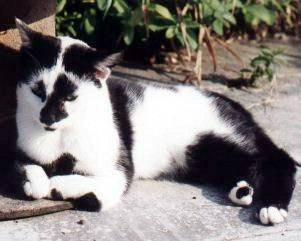
A squitten is a cat with a genetic deformity which causes a partial formation or complete absence of the radius bone making it resemble a squirrel. These cats should be kept indoors and seen to by specialist veterinarians, as long term management of the condition is essential for quality of life in these cats. It is an example of a cat body type genetic mutation. The word is a portmanteau of squirrel and kitten.
In genetics, expressivity is the degree to which a phenotype is expressed by individuals having a particular genotype. Alternatively, it may refer to the expression of a particular gene by individuals having a certain phenotype. Expressivity is related to the intensity of a given phenotype; it differs from penetrance, which refers to the proportion of individuals with a particular genotype that share the same phenotype.

Zinc finger protein GLI3 is a protein that in humans is encoded by the GLI3 gene.

Greig cephalopolysyndactyly syndrome is a disorder that affects development of the limbs, head, and face. The features of this syndrome are highly variable, ranging from very mild to severe. People with this condition typically have one or more extra fingers or toes (polydactyly) or an abnormally wide thumb or big toe (hallux).
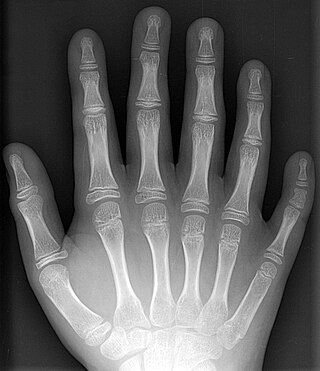
Supernumerary body parts are most commonly a congenital disorder involving the growth of an additional part of the body and a deviation from the body plan. Body parts may be easily visible or hidden away, such as internal organs.
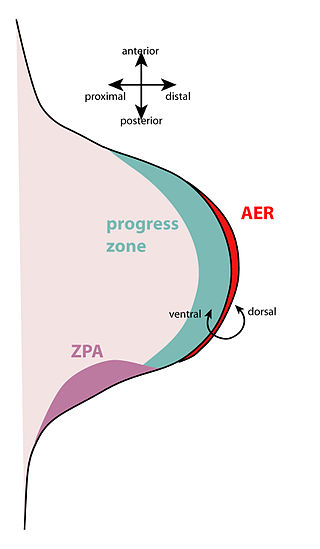
The apical ectodermal ridge (AER) is a structure that forms from the ectodermal cells at the distal end of each limb bud and acts as a major signaling center to ensure proper development of a limb. After the limb bud induces AER formation, the AER and limb mesenchyme—including the zone of polarizing activity (ZPA)—continue to communicate with each other to direct further limb development.
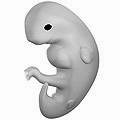
Limb development in vertebrates is an area of active research in both developmental and evolutionary biology, with much of the latter work focused on the transition from fin to limb.

Limb region 1 protein homolog is a protein that in humans is encoded by the LMBR1 gene.

Diplopodia is a congenital anomaly in tetrapods that involves duplication of elements of the foot on the hind limb. It comes from the Greek roots diplo = "double" and pod = "foot". Diplopodia is often found in conjunction with other structural abnormalities and can be lethal. It is more extreme than polydactyly, the presence of extra digits.

Acropectoral syndrome is an autosomal dominant skeletal dysplasia syndrome affecting the hands, feet, sternum, and lumbosacral spine. A recently proposed candidate gene for preaxial polydactyly is LMBR1, encoding a novel transmembrane receptor, which may be an upstream regulator of SHH. The LMBR1 gene is on human chromosome 7q36.
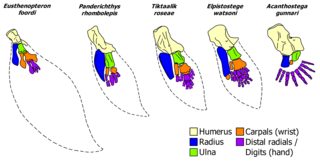
Polydactyly in stem-tetrapods should here be understood as having more than five digits to the finger or foot, a condition that was the natural state of affairs in the earliest stegocephalians during the evolution of terrestriality. The polydactyly in these largely aquatic animals is not to be confused with polydactyly in the medical sense, i.e. it was not an anomaly in the sense it was not a congenital condition of having more than the typical number of digits for a given taxon. Rather, it appears to be a result of the early evolution from a limb with a fin rather than digits.

Polysyndactyly is a congenital anomaly, combining polydactyly and syndactyly, in which affected individuals have an extra finger or toe that is connected, via fusing or webbing, to an adjacent digit.
In evolutionary biology, developmental bias refers to the production against or towards certain ontogenetic trajectories which ultimately influence the direction and outcome of evolutionary change by affecting the rates, magnitudes, directions and limits of trait evolution. Historically, the term was synonymous with developmental constraint, however, the latter has been more recently interpreted as referring solely to the negative role of development in evolution.

Familial opposable triphalangeal thumb duplication is a limb malformation syndrome and a type of pre-axial polydactyly, characterized by having duplicated opposable triphalangeal thumbs. This condition can be a symptom of other genetic disorders, such as Holt–Oram syndrome and Fanconi anemia. This trait is autosomal dominant and often runs in families. Sometimes big toe duplication, post-axial polydactyly, and syndactyly of the hand and feet can occur alongside this malformation Approximately 20 families with the condition have been described in medical literature.
